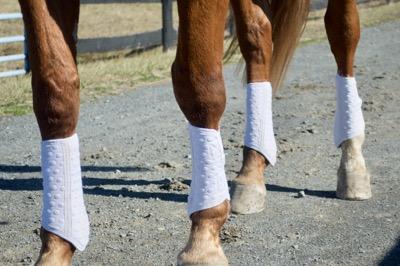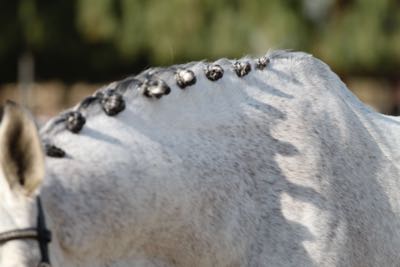All About Ergots and Chestnuts on Horses
Horse chestnuts are a few things – actual nuts that people eat, and those crusty formations on the inside of the horse’s leg. Ergots, on the other hoof, are on the underside of the fetlock joint. Both of these unique structures are the source of myth and perhaps annoyance and, for the most part, don’t require attention. Ergots and chestnuts on horses rarely need attention, unless there’s a reason.
Table of Contents
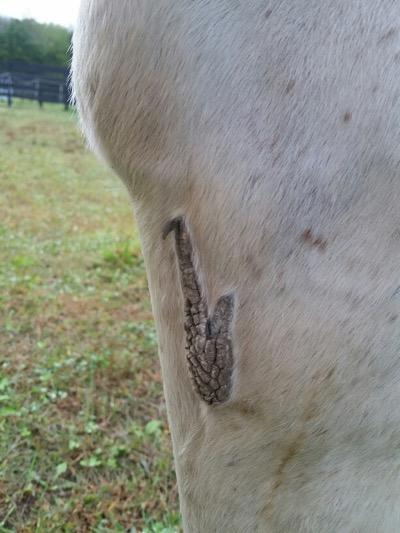
The Lore About Ergots and Chestnuts on Horses
- Chestnuts are sometimes called “night eyes,” which is a bit creepy. It was believed horses could see well at night because of their chestnuts. I can’t pinpoint when this rumor started, but it’s likely before modern ophthalmology. This is also quite the fun fact about a horse’s leg.
- In the land of horse tale folklore, some believe chestnuts and ergots on horses are vestigial scent glands. This theory of chestnuts as scent glands stems from the wives’ tale and old cowboy trick that you carry the chestnut peelings of another horse into a paddock, and the horses there will come up to you to investigate, thus making catching easier.
Are Chestnuts on Horses Really Extra Toes?
- Many believe that chestnuts are remnants of toes that have migrated, sometimes called vestigial toes. There’s conflicting information about this thought. At some point, ancient horses had three, four, or five toes. Did some of those toes become the splint bones alongside the cannon bones and the chestnuts?
- Recent evidence suggests that these extra toes, which started as five total, actually exist in the incredibly early stages of a foal’s development in the uterus to this day. As the foal grows, the toes combine to create a hoof that we know and love. This process is called digit reduction – instead of toes becoming other parts of a horse’s anatomy, the five toes become one hoof. More information on this topic can be found here.
- At any rate, it’s still commonly believed, by horse owners and experts alike, that chestnuts on horses are vestigial.
Here’s a link to the original New York Times article about chestnuts and toes.
Do all Horses Have Chestnuts?
- Most modern-day horses have chestnuts on all four legs. On the front legs, they are above the knee, and on the back legs, they are below the hock. Some breeds of horses, namely Icelandic and Caspian ponies, may be missing the hind leg chestnuts. Many horse relatives, like the zebra, don’t have hind leg chestnuts.

These chestnuts are bananas.
How to Care for Your Equine Partner’s Chestnuts
- Many of us like to keep chestnuts flat and tidy; otherwise, they can be a little lumpy and sometimes really pokey and long. The easiest way to keep them tidy is to peel them when they are wet. Peeling after a shampoo bath and rinse may be the best time to address them.
- Alternatively, you can keep them oiled with baby oil or moisturizer and peel them when they are nice and soft. Some folks use petroleum jelly to do this.
- I prefer not to use a blade or razor to remove them. In my hands, this is a recipe for disaster, cutting too deep or having a wiggling horse dance into a blade.
- Some farriers can trim up chestnuts for you with their hoof knife.
- On show day, you can spiff up your horse’s chestnuts with a coat of grooming oil or do nothing and carry on.
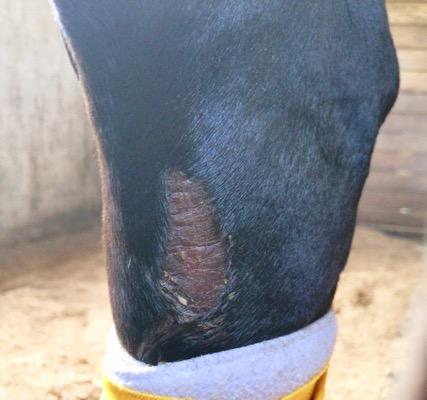
This horse lost their chestnut and had a nice fat leg because of it.
What’s “under “a horse chestnut?
- I never thought about this until I learned that a friend’s horse came in from the pasture with a big, fat leg. Cause of this? A suddenly missing chestnut. There’s no bleeding, but you can see from the photo below that there is skin-like tissue below the chestnut.
- It grew back to normal after several weeks.
Fascinating Science About Horse Chestnuts
- Some clever scientists looked at a small group of horses to see if laminitic changes to the hoof also show up in the chestnuts. Both structures have epithelial cells and proteins, among other things.
- They found that the cytokeratin cells (a type of epithelial tissue) in the hooves and chestnuts change during laminitis, and this change is not related to weight bearing. This suggests that changes to the hoof can affect the horse in other areas.
This summary provides additional information about the laminitis study.
- Other enterprising scientists examined the relationship between chestnut size, limb length, and breed. They found that size matters, at least when looking at chestnuts and breeds.
Read more about that study here.
- A similar study examined a wider variety of breeds, their typical shapes on chestnuts, and how to use them as identifying markers for breeds.
Read more about this science here.
All About Ergots on Horses
- Ergots have a similar texture to chestnuts but grow endlessly at the back of the fetlock. For this reason, I despise ergots and find them to be all sorts of annoying and strange.
- And who named them ergots? This silly word is a variation of the French word for “rooster spur, “which, TBH, is pretty spot on.
- It’s a bit more interesting to think about where ergots “came from.“ The horse’s living relatives of the order Perissodactyla are the tapir and the rhino. Creatures of the order Perissodactyla are odd-toed ungulates, meaning they have hooves with an odd number of toes.
- These creatures also have hoof pads or the remains of a hoof pad. It’s just as it sounds, like a built-in squishy pad that the hoof rests on. The theory is that the horse’s ergot is the remains of the hoof pad.
- Most horses have ergots, but some don’t.
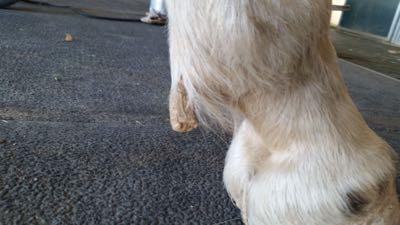
Ergots range in size from little nubs to this kickstand.
Caring for Horse Ergots
- Ergots are also easily removed in the wash rack after shampooing and rinsing, or even just a rinse. Much like chestnuts, you don’t have to do anything with them if you don’t want to!
- Small ergots that don’t extend or grow much feel like calluses or scabs.
- Use your fingernails to peel away the outer layers gently. Your farrier might also be able to trim them for you. Using a blade might be dangerous for your horse and your hands.
- Please don’t twist off the ergots. Many nerves and soft tissue structures meet at the back of the fetlock, where the ergot sprouts. Keep everything where it’s supposed to be, and don’t twist the ergot.
- One more note about ergots. Please don’t let them turn into gigantic kickstands, or I will hunt you down, peel them off, and then smack you with them. Gently.
Videos


FAQ’s
What is the purpose of horse chestnuts?
Chestnuts on horses are small callus-like growths on the inner side of a horse's legs. They have no known purpose and are considered a vestigial structure, a remnant from evolution with no current function in modern horses.
Do you have to remove chestnuts on horses?
Most horses have normal chestnuts that don't need alteration or grooming, per se. Some horses, who may have supernatural powers, grow wild chestnuts that need trimming. This is usually necessary when the growth rubs against other legs when sleeping.
Are chestnuts on horses related to coat color?
Coat color is genetic and related to pigments, skin, and hair. Chestnuts are structures, like the hoof, made of the protein keratin. They are also genetic, but entirely unrelated to a horse's coat color. It's a coincidence that chestnuts on horses are named the same as the chestnut color.
Should you remove chestnuts on horses?
It's unnecessary to remove chestnuts and ergots, but you can if they are causing pain or interfering with your horse's comfort. If they scratch their other legs while resting or sleeping, a trim from your farrier can help alleviate that.
Go Shopping
Stock up here for your horse supplies! As an Amazon Associate, I earn from qualifying purchases, but it’s ZERO extra cents to you. As a Walmart Associate, I earn from qualifying purchases as part of their affiliate plan. I appreciate your support! You can also visit my Amazon storefront here: PEG storefront.
This is my favorite horse care product for shine, conditioning, detangling, and stain protection.
For bits, sores, dry patches, cracked skin, and more. Great for your horse's first aid kit!
References
Kojouri, G. A., Shadkhast, M., Ziaiie, B., & Taghadosi, C. (2010). Characterizations of Chestnut in Relation to Age, Height and Body Weight in Equines. Vet Scan| Online Veterinary Medical Journal, 5(1).
Wattle, O. S. (2001). Cytokeratins of the matrices of the chestnut (torus carpeus) and periople in horses with acute laminitis. American Journal of Veterinary Research, 62(3), 425-432.

